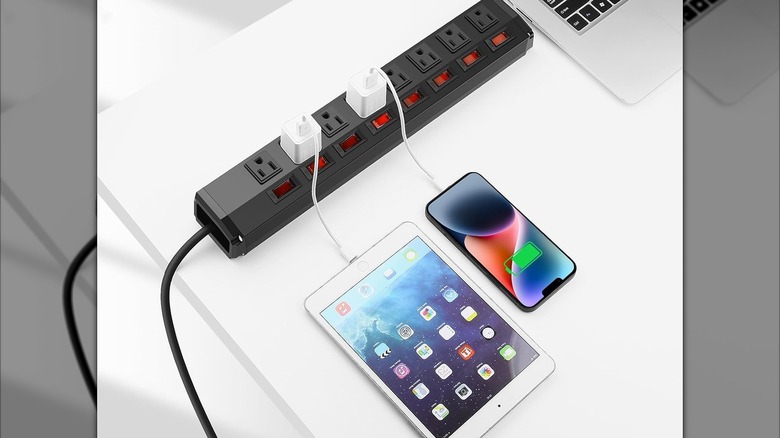Why Do Power Strips Have A Reset Button? Here's When To Use It
We may receive a commission on purchases made from links.
A surge protector or power strip with a surge protection can "clamp" a spike in electricity before it reaches sensitive devices. There are a few ways a surge protector accomplishes this, such as utilizing a metal oxide varistor to grab the extra energy and send it to ground, or with a built-in circuit breaker which trips when overloaded, among other methods. The latter option doesn't come with all surge protectors, but, just like when your home's lights go out during a storm, you need to flip back on the breaker to restore power, or in this case, press the reset button. So, if you're plugged into a surge protector (with a built-in circuit breaker), and your TV suddenly turns off, you'll need to utilize the reset function in order to power it up again.
Found in homes and workplaces, a power strip is an electrical accessary that allows for several devices to be plugged in at once. Of course, there are some things you should never plug into a power strip, such as something that produces significant heat. However, to clarify a common misnomer, there are power strips and surge protectors, which people often conflate. A basic power strip is simply a means to extend a one wall outlet into additional, to accommodate the bevy of modern devices requiring power. However, a surge protector, while looking nearly identical, includes another handy feature which protects your electronics from being damaged due to fluctuations in the flow of electricity.
Is the Off button the same as Reset?
Some power strips feature an "Off" switch, which can either consist of a single toggle or an option for each of the sockets. However, these switches simply cut power to the strip or a particular socket and have nothing to do with surge protection. While it may seem redundant at initial glance, the "Off" feature on a power strip does serve a very useful function. Yes, you can simply shut down the plugged-in device itself, but many electronics are still using energy even when they're powered down. If you've noticed a slight bump in your utility bill lately, it could be due to how much electricity your computer is using, even when it's off.
It's not just your PC though, other common electronics like gaming consoles and TVs are quietly using electricity while seemingly dormant. A TV for example, may have standby functionality, which essentially allows it to respond more quickly to your actions by continually drawing a bit of power. The way to mitigate this issue, is to plug these devices into a power strip or surge protector with an "Off" feature for every socket, which can ensure no power is getting through.

